Entrance Garden
The Entrance to the Botanical Gardens and the Creation Museum invites and welcomes you with a variety of seasonal plants on display, such as flowering cherry, viburnum, and large, red maple trees.
Overview of Entrance Garden
The Entrance to the Botanical Gardens and the Creation Museum invites and welcomes you with a variety of seasonal plants on display, such as flowering cherry and viburnum (a crowd favorite) and large red maple trees. As you enter, you will be greeted by one of our friendly guest services staff who will provide directions and information about our garden trails and answer questions you may have. They may also point out the pavilion spaces where guests can enjoy lunch, relax in the shade, or just take in the beauty of God’s creation. Welcome to the Creation Museum and the Botanical Gardens!
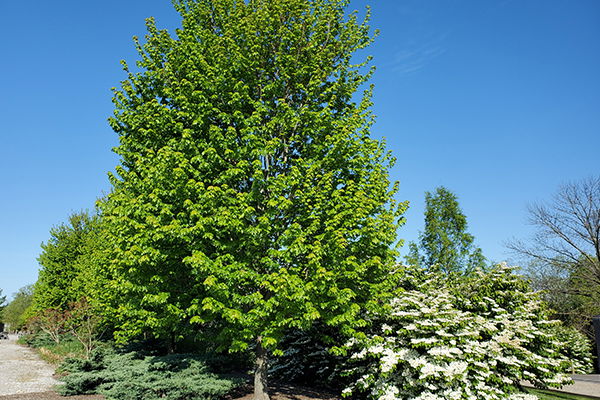
Autumn Blaze Maple
Common Name: Autumn Blaze Maple
Botanical Name: Acer x freemanii
Height: 40–55 feet
Spread: 30–40 feet
Location: Full sun to part shade
Bloom: N/A
Hardiness zone 3–8
Autumn Blaze is an appropriately named tree because it has fiery red leaves that appear in the fall. This is an older variety of hybrid maple crossing from the silver and red families that were discovered in 1960 and is considered a 50/50 mix between the two. It has a long track record as a fast growing, upright tree with an oval crown or top that is resistant to insect and disease problems.
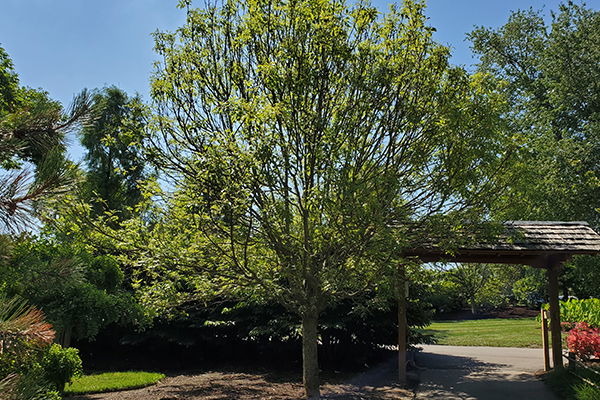
Golden Desert Yellow Ash
Common Name: Golden Desert Yellow Ash
Botanical Name: Franxinus excelsior
Height: 20–30 feet
Spread: 20–25 feet
Location: Full sun to part shade
Bloom:
Hardiness zone 4–7
The Golden Ash has a striking golden twig that really stands out in all seasons. The leaves emerge in the spring a light-yellow, then change to green during the summer, giving great contract to the golden branches. The leaves then change into a bright golden yellow in the fall that is impossible to miss. It is important to note that the Ash family is susceptible to and under attack from Emerald Ash Borer that causes damage or death to many of the trees.

Kentucky Coffee Tree
Common Name: Kentucky Coffee Tree
Botanical Name: Gymnocladus dioca ‘Expresso’
Height: 60–75 feet
Spread: 40–50 feet
Location: Full sun
Bloom: July to September, pink and white flower with red center
Hardiness zone 5–9
The large, compounded leaf of the Coffee tree gives it a distinct tropical look, but it is a midwestern U.S. native. It is a tall, deciduous tree with rough, scaly brown bark. It also has an interesting story. The name derives from early settlers roasting and grinding the seed pods for coffee. The pods are very toxic prior to roasting, so they should never be eaten fresh. No serious insect or disease problems are noted with the Coffee tree, so it is an easy to care for native that adds interest to any garden.

Grey Owl Juniper
Common Name: Grey Owl Juniper
Botanical Name: Juniperus virgiana
Height: 2–3 feet
Spread: 4–6 feet
Location: Full sun to part shade
Bloom: non-flowering
Hardiness zone 2–9
Grey Owl is a slower growing hybrid in the same family with other Red Cedars that are known to grow in most soil types and most temperature zones. It is an attractive wide-spreading evergreen with a silver-grey foliage used as a specimen, windbreak, or also as an erosion control plant on a hillside. It is in the evergreen category so you will have the addition of the silver-grey foliage for every season in your garden.

Golden Raintree
Common Name: Golden Raintree
Botanical Name: Koelreuteria paniculata
Height: 25–40 feet
Spread: 30–40 feet
Location: Full sun
Bloom: June to July, yellow
Hardiness zone 5–9
The Golden Rain tree has an irregular growth habit in its youth but matures into a more attractive symmetrical globe shape. Each leaflet of the larger compound leaf emerges a light yellow-green color turning all green for the summer then a golden yellow for the fall. This tree is named for its dramatic yellow flowers that form at the end of the branches in June and July and cover the tree with what looks like “Golden Rain.” The fruit grows after the flowers are spent and are uniquely shaped capsules that some say look like lanterns. They are yet another eye-catching element of this interesting and beautiful tree, although it is important to note that those capsules contain many seeds that cause this tree to be invasive in some places.
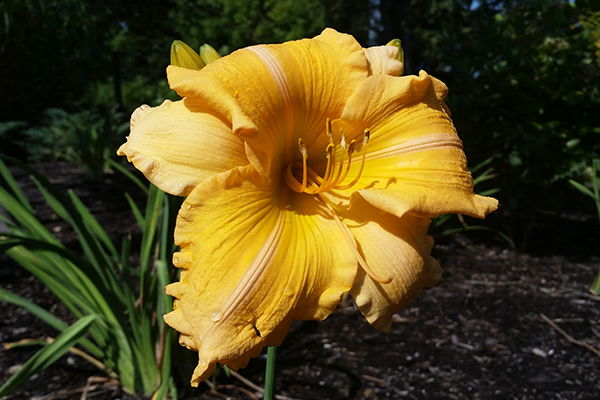
Orange Lily
Common Name: Orange Lily
Botanical Name: Lilium bulbiferum
Height: 3–4 feet
Spread: 7–12 inches
Location: Full sun to part shade
Bloom: May to June, orange flower
Hardiness zone 3–9
Hardy, undemanding, and easy to grow are some descriptions for these lilies. Other words like flamboyant and brilliant try to describe the orange color, but the words can only try to match what the eye sees. They are a perennial flower that grows 3 to 4 feet and could be used as a border plant, behind a row of shorter plants, or in a container to add color to any area. Whatever way you choose to plant them, they are sure to add a positive impact into your garden.

Dawn Redwood
Common Name: Dawn Redwood
Botanical Name: Metasequoia glyptostroboides
Height: 70–160 feet
Spread: 15–45 feet
Location: Full sun
Bloom: non-flowering
Hardiness zone 4–8
Dawn Redwood was once considered extinct until 1944 when it was discovered growing in central China. It is closely related to the bald cypress and sequoia redwoods. It is a fast-growing deciduous tree that is also a conifer—in other words, it drops its “leaves” that look like needles in the fall and produces cones like many other evergreens. The needles are softer than most evergreens and turn a rust color in the fall before dropping to expose the beautiful, fluted trunk with somewhat shaggy bark. This big, bold tree has proven to be adaptable to most soil types and easy to grow.

Giant Chinese Silver Grass
Common Name: Giant Chinese Silver Grass
Botanical Name: Miscanthus giganteus
Height: 9–12 feet
Spread: Clump
Location: Full sun
Bloom: September to frost, soft pink plumes
Hardiness zone 4–9
The name for this is accurate. It is a giant grass and requires little to no care other than the annual clean up. When choosing a spot for this one, keep in mind that the diameter of the base increases annually, but you can easily dig and split them if they get too big. We use ours as a separation plant or a wall from one area to another. You could also use it as a seasonal screen in your landscape or garden.

Autumn Flower Cherry
Common Name: Autumn Flower Cherry
Botanical Name: Prunus subhirtella ‘Autumnalis’
Height: 20–35 feet
Spread: 15–30 feet
Location: Full sun to part shade
Bloom: April, pink to white flowers
Hardiness zone 4–8
This cherry tree flowers heavily in the spring before the shiny green leaves emerge, then it blooms again in the fall or autumn, as the name suggests, although not as abundantly. It typically has a spreading, rounded growth habit with an open-branching structure. Autumn Flower Cherry is known to be resistant to disease, but like all cherries, it is susceptible to several insects that you will need to watch for.
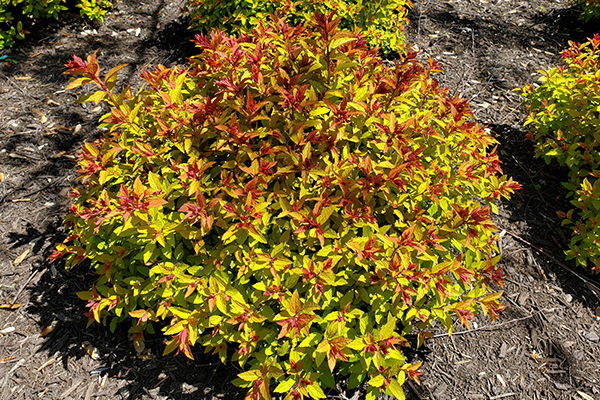
Magic Carpet Japanese Spirea
Common Name: Magic Carpet Japanese Spirea
Botanical Name: Spirea japonica
Height: 1–2 feet
Spread: 2–3 feet
Location: Full sun
Bloom: June to October, Pink flower
Hardiness zone 3–9
Magic Carpet is a bright colored deciduous shrub and a great choice for your garden! It bursts out in the spring with red leaves that turn a golden yellow in the summer, followed by pink flowers that emerge in June and last through October. That’s a lot of color for one plant! We prune ours back to about 12 inches in the early spring—all the care that they normally require. They also grow in most soil types and are insect and disease resistant.
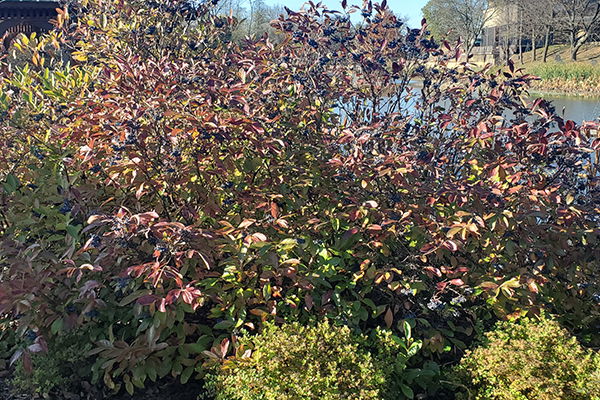
Winterthur Viburnum
Common Name: Winterthur Viburnum
Botanical Name: Viburnum nudum
Height: 5–12 feet
Spread: 5–12 feet
Location: Full sun to part shade
Bloom: April to May, white flower
Hardiness zone 5–9
Winterthur is a multi-stemmed cultivar of Viburnum Nudum, which is native to the eastern U.S. and can be found in lower lands or boggy areas. It has white clusters of flowers contrasting its shiny green leaves in the spring, followed by berries ranging from pink to blue in the fall. The berries normally hold onto the plant into the winter for more seasonal interest.
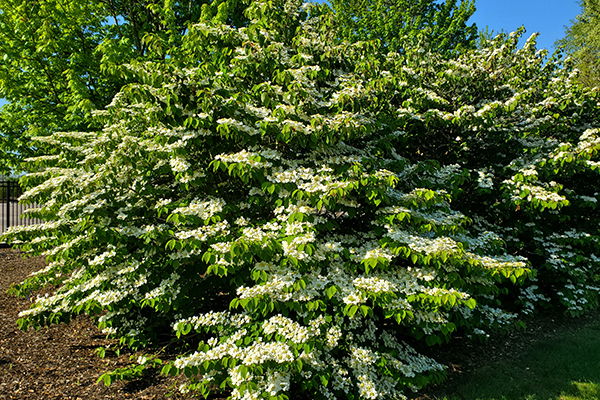
Doublefile Viburnum
Common Name: Doublefile Viburnum
Botanical Name: Viburnum plicatum var. tomentosum ‘Mariesii’
Height: 10–16 feet
Spread: 12–15 feet
Location: Full sun to part shade
Bloom: April to May, white flower
Hardiness zone 4–8
Doublefile viburnum is named for its double rows or files of white flowers that appear profusely along its horizontal branching in April or May. After the flowering season is over, the red-berried fruit will appear, then change to black as the season progresses. The green leaves will also turn to a beautiful auburn. The fruit is attractive and a good late-season food source for birds. This multi-stemmed shrub will thrive in a variety of soil types, but it does prefer ample moisture. The Creation Museum Botanical Gardens uses this plant as a divider or wall that separates garden areas, though you could plant it as an individual specimen in your garden.